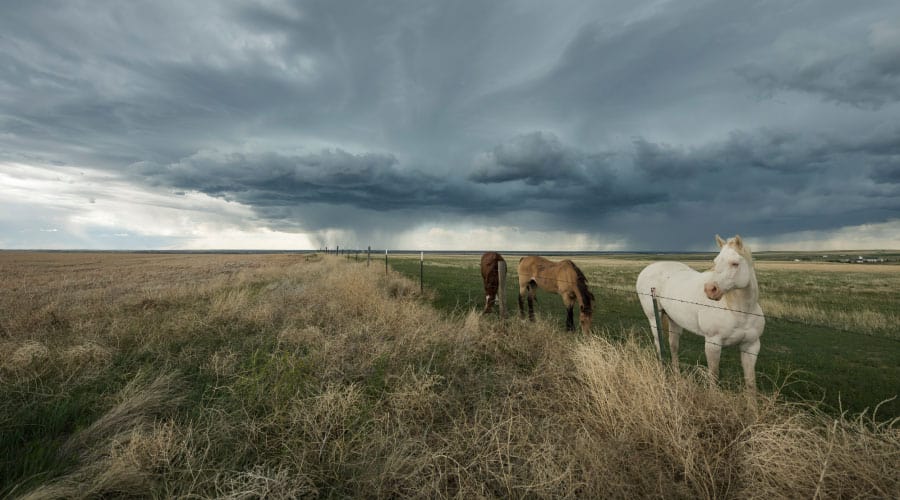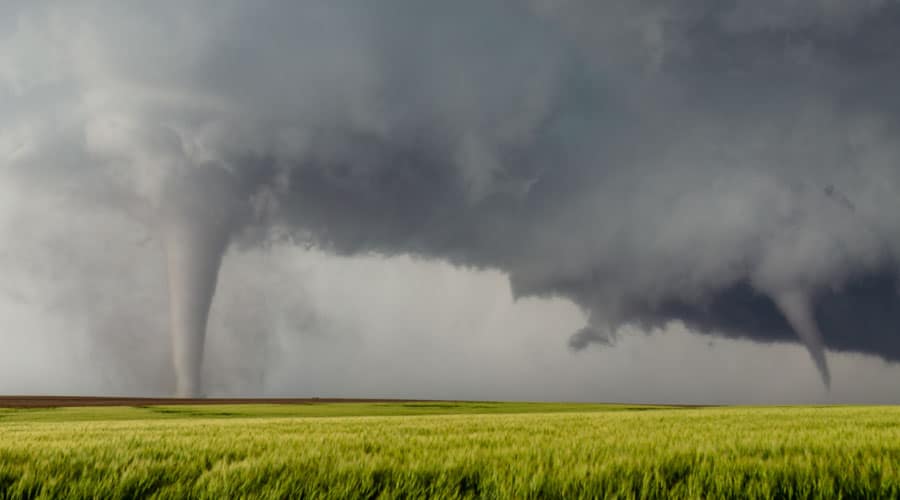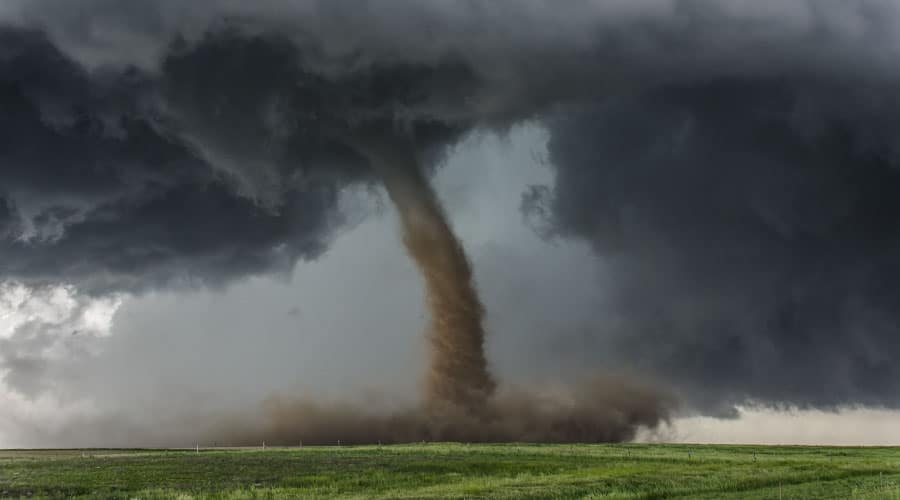
Deciding what to do with horses in a tornado can be a tricky decision to make. You may feel that making the wrong decision could be devastating or that you are dammed either way and leave it up to chance or a ‘gut feel’. I hope that this post will help you make a more informed decision and provide a few tips on how to stay prepared during tornado season.
Depending on the tornado scale, most horse owners choose to leave their horses outside in order to give them a chance to fight the elements instinctively. Leaving horses out will run the risk of them getting hit by flying debris or breaking free and getting lost. Keeping horses inside the bard will protect them from getting hit by debris but you run the risk of the barn collapsing on top of them.
The decision is usually whether to leave your horse out in the field or to keep them inside the barn. Choosing the right way can sometimes feel like a luck of the draw.
Tornados
Tornado scale
F0 – possible damage is light such as broken branches from trees and minor roof damage. Wind speeds reaching between 40-72 mph.
F1 – possible damage is moderate such as snapped trees, shifts in mobile homes, and damaged roofs. Wind speeds reaching 73 -112 mph.
F2 – considerable damage is possible such as mobile homes being demolished, trees becoming unrooted, and strongly build homes may become unroofed. Wind speed reaching 113 -157 mph.
F3 – possible damage is severe such as cars can be lifted off the ground, trains can be overturned, strongly build homes can have outside walls blown away. Wind speeds reaching 158 -206 mph.
F4 – Possible devastating damage such as houses leveled to debris, cars (livestock) thrown through the air. Wind speeds reaching 207 -260 mph.
F5 – Incredible amount of damage possible: Strongly build houses can completely blow away cars become missiles. Wind speeds reaching 261 -318 mph. Fewer than 2%.
When and where do tornadoes occur?
- Tornadoes can occur in many countries around the world, but they are most often seen in the United States where the most commonly affected areas are known as “Tornado Alley.”
- Tornadoes can happen at any time of the year but are normally seen from April into early June in the United States.
- Tornadoes can happen at any time of the day or night; most tornadoes occur between 4–9 p.m.
Where is the safest place to be?
This can sometimes be a life or death decision to make for a horse owner.

Outside
Choosing to put your horse in a large pasture will give your horse the opportunity to use his instincts to move around and out of the path of the storm, and allow him to either seek shelter or run from the tornado. The fact that they can move around is the primary benefit of leaving them out, an option that stabled horses do not have if the tornado ends up passing through the barn and collapsing on your horse.
If you have a large, open pasture available for your horse, then this is generally the best option, especially for the stronger more damaging tornadoes.
Inside
The biggest advantage of leaving them inside is that they will be protected from getting hit and stabbed by flying debris or getting struck by lightning. This will, of course, depend on your barn structure. If you have a barn made of brick and concrete, then keeping them inside during the less damaging tornadoes such as F1 and even F2 might be safer.
Remember that for the more damaging tornadoes such as F4 or F5, it will not matter how strong your barn structure is, taking a direct hit will most likely not hold.
Barn design
Not everyone can afford a tornado-proof barn or a tornado safe room for horses. However, strongly build barns of brick and thick concrete is the best way for keeping your horse safe when choosing to keep them inside, as it will be able to withstand more damaging tornadoes than say a barn made of wood or metal.
How can you prepare?
A tornado warning can come at an instant, so being prepared ahead of time is crucial for helping your horse survive a potentially life-threatening storm.

Prepare your horse’s paddock
Make sure you remove any debris or items from pastures that could add injury to your horse. Having tall trees around the paddocks can help protect your horse from lightning strikes when they roam in open field paddocks.
Prepare your horse
Horses that are outside during the tornado should wear a fly-mask to protect their eyes from injury. Some people even recommend putting your heaviest turnout blankets and boots on to try and protect them from flying debris, but I personally wouldn’t want my horse to overheat. I would, however, consider using turnout boots.
Another way you can prepare your horse is to ensure that your contact details are somewhere to be found on the horse in case he breaks free from the pasture during the storm. That way your horse can be returned to you when found. These days most competitive horses and even some stud farm horses have microchips containing all the details, but that would still need a vet to scan the horse and locate the owner.
Leather halters can also be used, or you can even put your contact details inside a durable freezer bag and stick it to the halter. Some owners will even paint their phone numbers on their horses’ bodies. Whatever the method you use, it’s important that your horse can be traced back to you when lost.
Do people evacuate their horses?
Not really. It’s way more dangerous to be on the roads during a tornado. Tornadoes are unpredictable and can’t be outrun. Perhaps some people might choose to relocate their horses during tornado season by removing them from the at-risk areas before a storm arrives and transporting them to another location. But this is both costly and impractical.
Can horses predict a tornado?

There are many people who believe that horses can sense weather phenomena. I myself believe that Horses do have a sixth sense when it comes to weather and reacts instinctively to predictable, and unpredictable weather changes.
Horses seem to exhibit strange behavior just before storms occur, and they can quickly adapt and get themselves out of harm’s way. Have you ever noticed how your horse’s mood can change with the weather? We have all seen how our horses can react when there is a storm approaching. They can sense it, and they can feel it brewing.
For example, Horses are always fresher and excitable in windy cloudy weather. They can become a bit more anxious, spooky, and difficult to handle with a storm approaching and can sometimes feel lethargic in the summer heat.
When it comes to surviving tornadoes, even the most domesticated horses’ survival instincts will kick in and they will do what they can to be safe and survive.
They will try and seek the safest place, whether that means finding shelter or making a run for it. That is another reason why many horse owners choose to leave their horses out in the field as horses will instinctively know how to get themselves out of harm’s way and they will seek the safest spot to shelter in when a tornado hits.
Conclusion
At the end of the day, and as difficult as it may be, it’s important to remember human life comes first and to not danger yourself or your staff when dealing with mother nature.
Horses are flight animals by nature and have incredible instincts when it comes to survival.
